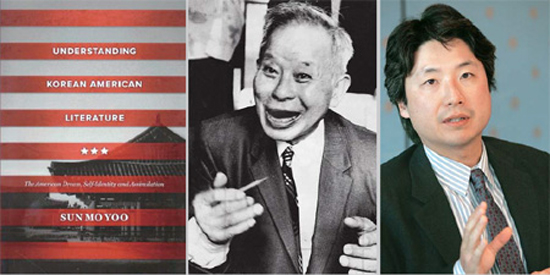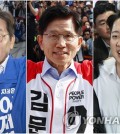- California Assembly OKs highest minimum wage in nation
- S. Korea unveils first graphic cigarette warnings
- US joins with South Korea, Japan in bid to deter North Korea
- LPGA golfer Chun In-gee finally back in action
- S. Korea won’t be top seed in final World Cup qualification round
- US men’s soccer misses 2nd straight Olympics
- US back on track in qualifying with 4-0 win over Guatemala
- High-intensity workout injuries spawn cottage industry
- CDC expands range of Zika mosquitoes into parts of Northeast
- Who knew? ‘The Walking Dead’ is helping families connect
Beyond ethnicity

From left are a book titled “Understanding Korean-American Literature” (Variety Crossing Press, Canada, 2013); Korean American authors Younghill Kang; and Chang-rae Lee. The book offers a glimpse of
the short history of Korean-American literature from its early period in the 1930s up to the present day and the future potential for it through diverse theme changes over time. (Daesan Foundation and Korea Times file)
Korea Americans’ clout growing in US literary scene
By Chung Ah-young
When new ethnic writers began gaining recognition on the U.S. literary scene in the 1990s, a sudden surge of work by Korean-American authors led to something akin to a “Korean American literary renaissance.” Now, the American literary world is an open port for ethnic literature, offering further opportunities for Korean American authors.
As the presence of Korean-American writers grows there, academic circles here have recently begun to pay more attention to them in a bid to embrace their work as a separate genre within Korean literature.
“Understanding Korean-American Literature” (Variety Crossing Press, Canada, 2013), a recent book, written by Yoo Sun-mo in English, professor emeritus at Kyonggi University’s Department of English Literature, offers a glimpse of the short history of Korean-American literature from its early period in the 1930s up to the present day and the future potential for it through diverse theme changes over time.
According to the book, there are no clear cut definition and categorization for Korean-American writers because their nationality, the settings of which they write, subject matter and language used are complex. On the Korean literary scene, writers from here living abroad are included in the overall category of Korean writers as a way of gradually broadening the scope of Korean literature, while American critics and readers generally agree that the work must be written in English to be considered part of American literature.
This book attributes special meaning to those authors because they have the potential of becoming recognized as part of the ethnic literature genre in American literary circles, which defines trends in the largest publishing market, and which is always seeking new authors and titles.
In this book, the Korean American authors are categorized by era: authors from the 1930s, 1960s, 1980s, and the 1990s and also according to themes: the nightmare of comfort women during the Japanese period of occupation, the Korean War and division of the peninsula, and children’s literature and by generation: the first, “one point five”, second, and third.
Yoo explained that literary activity among Korean American authors became increasingly visible during the 1990s as the multicultural literary movement took root in California. This was due, in part, to a dearth of subject material in mainstream literature. Also, as the status of Asians grows in American society and one point five generation writers overcame the language barrier, it was getting easier to have books published.
Writers categorized as first generation, including Il-Han New, Younghill Kang, Induk Pahk, Ty Pak Kichung Kim and Peter Hyun, usually produced autobiographical novels or memoirs about the painful immigration life in the early period. One point five generation writers such as Chang-rae Lee, Helie Lee, Joe Porcelli, and Heinz Insu Fenkl, often recount memories of their parent’s immigrant struggles and their childhood. Second generation writers such as Leonard W. Chang, Walter K. Lew, Margaret K. Pai, Ronyoung Kim and Marie G. Lee simultaneously touch on the struggle of assimilation into mainstream American society and the pursuit of Korean identity. Third generation writers such as Cathy Song, Gary Yong Ki Pak, and Don Lee tend to write stories about immigrant experiences in a more indirect way by referring to their grandparents, according to the book.
Their themes have changed over time from the American dream to immigrant struggles, Korean identity and themes of human universality. However, as their overarching theme is the pursuit of Korean identity, they face the challenges of transcending the label of “ethnic minority writers” and ultimately joining mainstream literature as “American writers.”
Don Lee says in the book that he hopes in the coming years that Korean-American writers will be able to transcend their ethnicity as a definitive label.
“I liken our current status to writers such as Bernard Malamud, Philip Roth, and Saul Bellow in the 1960s. They were indentified firstly as Jewish writers. Now, however, they are writers who are American and incidentally Jewish. I’d like to see the same thing happen with Korean American writers ― they are spoken of as ‘American writers.’”
Kichung Kim notes that Korean-American literature has emerged fairly recently but that energy and talent is evident within it.
“In this sense, the future of Korean American literature is very bright. I have no doubt we’ll see more and more Korean American writers taking center stage in the U.S. with important works in all genres,” Kim stated in the book.
Yoo writes that in the 21st century, Korean-American authors will increase in number and move forward in the direction of assimilation, exploring American material in their pursuit of Korean identity. Yoo cites Chang-rae Lee’s quotes, saying that a Korean author cannot rely on his or her own identity alone, because it limits the imagination when there is a deep attachment to a specific view and theme.
“Rather than extend the dark past that was devoted to sadness, hardship and misfortune, Korean literature can embrace hope and dreams of the future that can evoke powerful and charming emotions,” Yoo writes.












